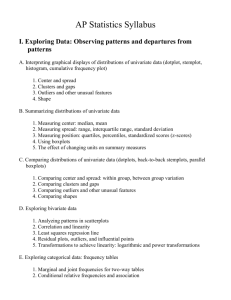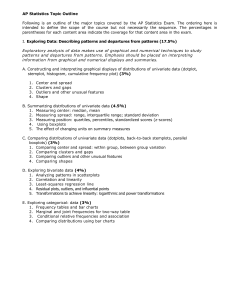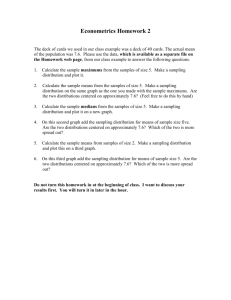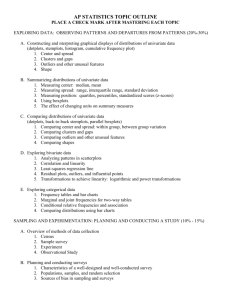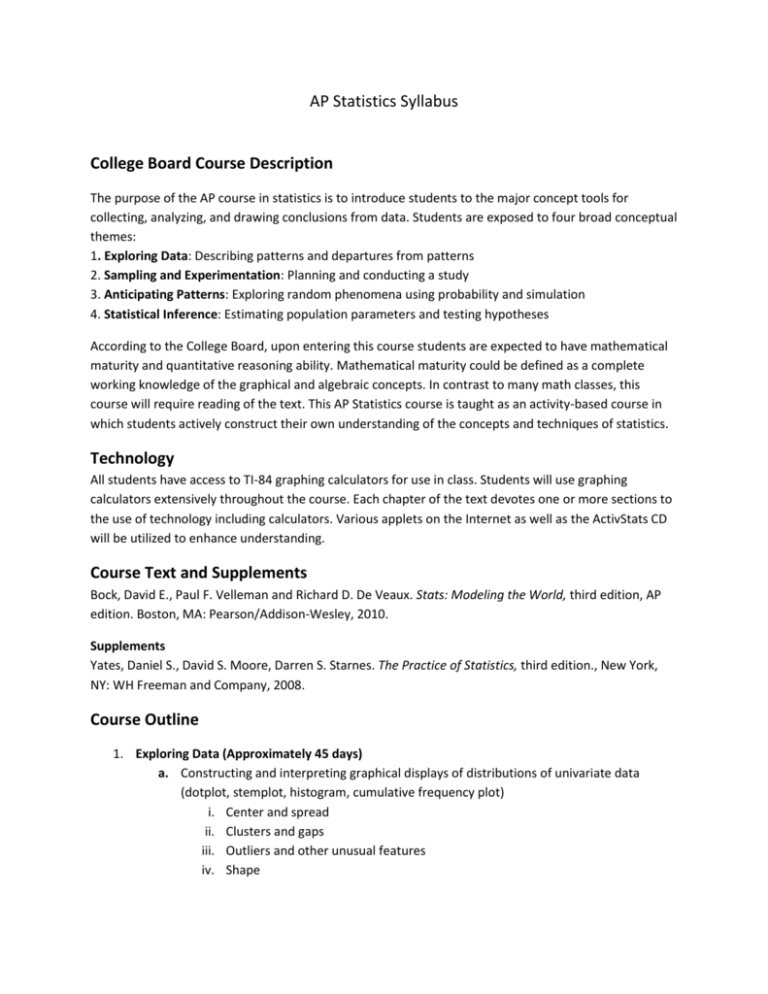
AP Statistics Syllabus
College Board Course Description
The purpose of the AP course in statistics is to introduce students to the major concept tools for
collecting, analyzing, and drawing conclusions from data. Students are exposed to four broad conceptual
themes:
1. Exploring Data: Describing patterns and departures from patterns
2. Sampling and Experimentation: Planning and conducting a study
3. Anticipating Patterns: Exploring random phenomena using probability and simulation
4. Statistical Inference: Estimating population parameters and testing hypotheses
According to the College Board, upon entering this course students are expected to have mathematical
maturity and quantitative reasoning ability. Mathematical maturity could be defined as a complete
working knowledge of the graphical and algebraic concepts. In contrast to many math classes, this
course will require reading of the text. This AP Statistics course is taught as an activity-based course in
which students actively construct their own understanding of the concepts and techniques of statistics.
Technology
All students have access to TI-84 graphing calculators for use in class. Students will use graphing
calculators extensively throughout the course. Each chapter of the text devotes one or more sections to
the use of technology including calculators. Various applets on the Internet as well as the ActivStats CD
will be utilized to enhance understanding.
Course Text and Supplements
Bock, David E., Paul F. Velleman and Richard D. De Veaux. Stats: Modeling the World, third edition, AP
edition. Boston, MA: Pearson/Addison-Wesley, 2010.
Supplements
Yates, Daniel S., David S. Moore, Darren S. Starnes. The Practice of Statistics, third edition., New York,
NY: WH Freeman and Company, 2008.
Course Outline
1. Exploring Data (Approximately 45 days)
a. Constructing and interpreting graphical displays of distributions of univariate data
(dotplot, stemplot, histogram, cumulative frequency plot)
i. Center and spread
ii. Clusters and gaps
iii. Outliers and other unusual features
iv. Shape
Chapters: 1 – 4
Activity: M&M Data Collection
Technology: Enter data in lists, create histograms, and explore effect of class width on histogram shape
b. Summarizing distributions of univariate data
i. Measuring center: median, mean
ii. Measuring spread: range, interquartile range, standard deviation
iii. Measuring position: quartiles, percentiles, standardized scores (z-scores)
iv. Using boxplots
v. The effect of changing units on summary measures
Chapters: 4, 6
Activity: M&M Mean and Standard Deviation
Technology: Calculate 1-variable statistics, use normal cdf and invnorm commands
c. Comparing distributions of univariate data (dotplots, back-to-back stemplots, parallel
boxplots)
i. Comparing center and spread: within group, between group variation
ii. Comparing clusters and gaps
iii. Comparing outliers and other unusual features
iv. Comparing shapes
Chapter: 5
Activity: Auto Safety Boxplots
d. Exploring bivariate data
i. Analyzing patterns in scatterplots
ii. Correlation and linearity
iii. Least-squares regression line
iv. Residual plots, outliers, and influential points
v. Transformations to achieve linearity: logarithmic and power transformations
Chapters: 7 – 10
Activity: Sibling scatterplots, How many licks to the center of the tootsie pop?,Decay of skittleium
Technology: Display scatterplots, perform regression, calculate residuals, create residual plots, perform
transformations using lists
e. Exploring categorical data
i. Frequency tables and bar charts
ii. Marginal and joint frequencies for two way tables
iii. Conditional relative frequencies and association
iv. Comparing distributions using bar charts
Chapters: 3, 4
Activity: Students will analyze and interpret statistical information about race and the death penalty.
They will write a newspaper article discussing the association between race and death sentences in the
United States. The writing will include visual, numerical, and verbal support for their position.
2. Sampling and Experimentation (Approximately 25 days)
a. Overview of methods of data collection
i. Census
ii. Sample Survey
iii. Experiment
iv. Observational study
Chapters: 11 – 13
b. Planning and conducting surveys
i. Characteristics of well-designed and well-conducted survey
ii. Populations, samples, and random selection
iii. Sources of bias in sampling and surveys
iv. Sampling methods, including simple random sampling, stratified random
sampling, and cluster sampling
Chapter: 11
Activity: Why Randomize?, Methods of Sampling
c. Planning and conducting experiments
i. Characteristics of well-designed and well-conducted experiment
ii. Treatments, control groups, experimental units, random assignments, and
replication
iii. Sources of bias and confounding, including placebo effect and blinding
iv. Completely randomized design
v. Randomized block design, including matched pairs design
Chapter: 13
Activity: Bean Bull’s Eye Activity
d. Generalizability of results and types of conclusion that can be drawn from
observational studies experiments, and surveys
Activity: M&M Experiment
Technology: Generating Random Numbers
3. Anticipating Patterns (Approximately 45 days)
a. Probability
i. Interpreting probability, including long-run relative frequency interpretation
ii. Law of large numbers concept
iii. Addition rule, multiplication rule, conditional probability, and independence
iv. Discrete random variables and their probability distributions, including binomial
and geometric
v. Simulation of random behavior and probability distributions
vi. Mean (expected value) and standard deviation of a random variable, and linear
transformation of a random variable
Chapters: 14 – 15
Activity: Rock, Paper, Scissors, Art
Technology: Calculate mean and standard deviation of a random variable, geometric probabilities,
binomial probabilities
b. Combining independent random variables
i. Notion of independence versus dependence
ii. Mean and standard deviation for sums and differences of independent random
variables
Chapter: 16
c. The normal distribution
i. Properties of the normal distribution
ii. Using tables of the normal distribution
iii. The normal distribution as a model for measurements
iv. Sampling distributions
v. Sampling distribution of a sample proportion
vi. Sampling distribution of a sample mean
vii. Central limit theorem
viii. Sampling distribution of a difference between two independent sample
proportions
ix. Sampling distribution of a difference between two independent sample means
x. Simulation of sampling distributions
xi. T-distribution
xii. Chi-square distribution
Chapters: 17, 18, 23, 26
Technology: t-test, p test, Chi-square
4. Statistical Inference (Approximately 35 days)
a. Estimation
i. Estimating population parameters and margins of error
ii. Properties of point estimators, including unbiasedness and variability
iii. Logic of confidence intervals, meaning of confidence level and confidence
intervals, and properties of confidence intervals
iv. Large sample confidence interval for a proportion
v.
vi.
vii.
viii.
Large sample confidence interval for a difference between two proportions
Confidence interval for a mean
Confidence interval for a difference between two means (unpaired and paired)
Confidence interval for the slope of a least-squares regression line
Chapter: 19
Activity: Capture, Recapture
Technology: Confidence intervals
b. Tests of significance
i. Logic and significance testing, null and alternative hypothesis, p-values, oneand two-sided tests, concepts of Type I and Type II errors, concept of power
ii. Large sample test for a proportion
iii. Large sample test for a difference between two proportions
iv. Test for a mean
v. Test for a difference between two means (unpaired and paired)
vi. Chi-square test for goodness of fit, homogeneity of proportions, and
independence (one- and two-way tables)
vii. Test for the slope of a least-squares regression line
Chapters 21,22,24,27
Activity: M&Ms Goodness of Fit Activity, Global Toss Activity
Technology: Testing a hypothesis, Creating confidence interval
5. Review for AP Exam, Presentation of Culminating Project, AP Exam (Approximately 25 days)
AP Statistics Culminating Project
Students will conduct an observational study of their choosing. (Topic must be approved by instructor).
Data will be collected either by survey or Internet research. The project will be done individually – a
written report and presentation are required.
Written Report
Students will pose a question, and, before conducting their study, they will make a conjecture
about the conclusion.
A brief introduction describing why that question was chosen and the manner in which they will
form a statistical conclusion.
Next, using a survey or Internet research, students will collect their data (with a minimum
sample size of 30).
The students will define how their data was collected and if there are any confounding factors to
worry about.
Once the data is collected, an appropriate graphical display should be constructed and any
observations documented about the data distribution.
Next, the proper test should be conducted (making sure to verify any assumptions).
Once the test has been conducted, the student should use the test results to form a statistically
sound conclusion (making sure the conclusion is worded properly and in context of the study).
Finally, the students will reflect on the study and the conclusion and state any bias,
confounding, or problems with design.
Oral Presentation
The individual students will briefly present their study and conclusion to the class using audio/visual
aids such as posters, PowerPoint, document camera, smartboard, etc. Following the presentation,
the students will field questions from class.
AP Credit
UK
3
4
5
SPA 202
SPA 320
SPA 320 or 322
Morehead 3, 4 or 5
MAT 123
EKU
3
4 or 5
STA 215
STA 270
BSCTC
3, 4 or 5
STA 220


